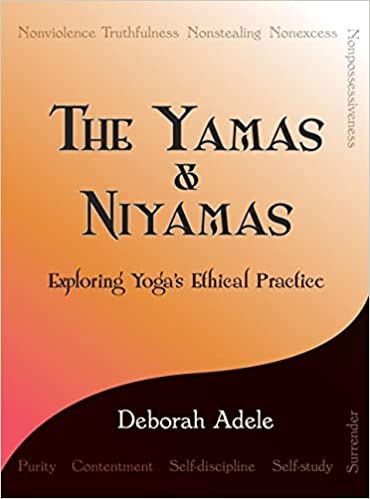- Meaning of Yamas
- 5 Yamas in Yoga
- First Yama – Ahimsa
- Second Yama – Satya
- Third Yama – Asteya
- Fourth Yama – Brahmacharya
- Fifth Yama – Aparigraha
- Books to study

Yoga is not just a physical practice but also a path to spiritual and emotional well-being. The ancient sage Patanjali’s Yoga Sutra, written around 200 CE, provides a comprehensive guide to the holistic approach towards yoga. One of the key concepts of the Yoga Sutra is the Eight Limbs of Yoga, which includes ethical guidelines to practice yoga and live a healthy life known as the Yamas.
The Yamas are the first limb of the Eight Limbs of Yoga and are considered the foundation of the whole yoga practice. Yamas are a set of moral and ethical principles that guide yogi’s behaviour towards themselves and others.
In this article, we will explore the yamas in more detail and provide practical tips on how to incorporate them into daily life and yoga practice. By the end of this article, you will have a deeper understanding of the yamas and their importance in yoga and daily life.
What is the meaning of Yamas?
Yamas are a set of 5 ethical guidelines that are an important part of the practice of yoga. The term “yamas” comes from the Sanskrit word “yam,” which means “to restrain” or “to control.”
In yoga philosophy, Yamas are often described as a set of “don’ts” or things we should refrain from doing. However, they are more than just rules to follow; they are principles that guide us towards a more conscious and compassionate way of living.
The purpose of practising the yamas in yoga is to develop self-control and cultivate moral discipline. By following the ethical guidelines of the yamas, a yogi can purify their thoughts and actions, leading to the development of a more compassionate and mindful approach to life.
Moreover, practising the yamas can help you create a harmonious and peaceful relationship with the world around them, promoting unity, respect, and understanding.
Difference between Yamas and Niyamas
The Yamas should not be confused with Niyamas which is the second limb of yoga. While Yama teaches us how to interact with the world around us, Niyama focuses on how we can improve ourselves from within. Yama guides us on how to behave towards others, while Niyama helps us cultivate self-discipline and spiritual growth.
Together, Yama and Niyama form a set of moral codes of conduct comprising ten principles for living a meaningful and purposeful life, both on and off the mat.
What are the 5 Yamas in Yoga?

The 5 Yamas are mentioned in Yoga Sutra chapter 2 (SADHANA PADA) verse 30. According to Sage Patanjali’s Eight Limbs of Yoga, The five yamas are:
- Ahimsa (non-violence)
- Satya (truthfulness)
- Asteya (non-stealing)
- Brahmacharya (celibacy)
- Aparigraha (non-greed)
The 5 Yamas of yoga deal with our behaviour or actions that affect our relationship with the outer world; that’s why Yamas are also called the self-restraint principles or ‘don’ts’.
Each of the five yamas can be explained as opposition to our five natural behaviour or actions of our day-to-day life. The practice of yamas involves restraining our natural tendencies and cultivating positive qualities such as non-violence, truthfulness, non-stealing, self-control, and non-greediness. For example:
- Harming or violence towards oneself or others is Himsa, restraining this behaviour and practising harmlessness towards all beings is called Ahimsa, the first Yama.
- Falsehood or dishonesty in thought, speech, or action is Asatya; commitment to truthfulness in all aspects of life is called Satya, the second Yama.
- Stealing or taking what is not freely given is Parasteya, refraining from stealing or taking what is not freely given is called Asteya, the third Yama.
- Indulging in excess or immoderation in all aspects of life is Brahmacharya, practicing self-control and moderation in all aspects of life is called Brahmacharya, the fourth Yama.
- Hoarding or attachment to material possessions is Aparigraha, letting go of greed and attachment to material possessions is called Aparigraha, the fifth Yama.
However, in Hatha Yoga Pradipika, there are additional yamas outlined and it excludes aparigraha. The yamas of Hatha Yoga Pradipika is a combination of 4 restraints and 6 disciplines that must be followed by everyone. The 10 yamas according to Hatha Yoga Pradipika are:
- Ahimsa (Non-violence)
- Satya (Truthfulness)
- Asteya (Non-stealing)
- Brahmacharya (Celibacy)
- Kṣama (Forgiveness)
- Dhrti (Fortitude, perseverance, courage)
- Daya (Compassion)
- Arjava (Sincerity)
- Mitahara (Measured diet)
- Shoucha (cleanliness)
The First Yama – Ahimsa (Non-violence)

The first in the five yamas is ‘Ahimsa’; the ethical behaviour of not harming oneself or others in thoughts, words and actions.
The prefix “a” in Sanskrit denotes “not,” while the word “himsa” is translated as “harming, injuring, killing, or committing violence.”
Ahimsa can be boiled down to the following:
- Refraining from harming others, ourselves, or nature physically
- Abstaining from thinking unfavorably about others or ourselves
- Ensuring that our actions and mannerisms promote peace as opposed to inflicting suffering
When we adopt the ahimsa mentality, we act with a perspective of non-harm. We nurture self-love, which opens the door to the love of all beings, by remaining steadfast in our resolve and attitude of complete love and empathy for life itself. We also let go of any desire to injure or harbor any kind of animosity against other people or ourselves.
How to practice Ahimsa (Non-violence)
- Cultivate Compassion: Make an effort to treat yourself and others with more compassion, acceptance, and forgiveness.
- Mindful Yoga Practice: Keeping Ahimsa in mind while doing yoga helps us to let go of negative body image thoughts and embrace ourselves entirely, despite how agile or sturdy we are currently.
- Listen to Your Body: Spend some time in each position observing how your body feels and what it needs. You can avoid injury and complete your practice while giving your body the exact nutrients it requires in this manner.
- Balance and Moderation: While Ahimsa promotes avoiding killing another living being, and hence refraining from eating animals, there must be a balance. It’s crucial to take into account what functions best if eliminating specific foods from your diet harms you.
- Positive Thinking: Our general well-being is greatly influenced by our thoughts as well. Not only should we be aware of what we think, but also of those of others. Even when intended at someone else, bitterness, hatred, and jealousy only serve to make us feel miserable.
Also read: 8 actionable ways to practice Ahimsa in daily life
The Second Yama – Satya (Truthfulness)

The concept of Satya, or truthfulness, in yoga, involves being honest with ourselves about our limitations and abilities and respecting our body’s needs and boundaries. It’s about discovering the most authentic version of ourselves and then acting on it, as there is no distinction between our thoughts, words, and deeds.
Practice of Satya enables fresh thoughts and observations to emerge and helps us perceive things more clearly than we originally could. Satya is more than just honesty; it goes above straightforwardness. The direct translation of the term “sat” is “true essence” or “unchangeable,” which lets us define our truth, even if our thoughts, feelings, and moods are interchangeable.
Living in your truth fosters respect, honor, and integrity, which enables a deeper understanding of the yogic path’s deeper truths. When there is uniformity in our thoughts and deeds, we are said to be in the state of Satya. This prevents our created self from taking precedence over our actual self, allowing us to recognize the divine inside us. Perceiving our convictions from a fresh angle, we come to truly realize Satya since nothing is absolute.
How to practice Satya (Truthfulness)
- Practising honesty: Learn to detect your internal anxieties and other unpleasant emotions, which might cause you to distort reality. Avoid lying to others and always talk kindly, compassionately, and clearly.
- Creating space for honesty: To be completely honest with ourselves, we must make a small amount of room, maintain some calm, or at the very least, slow the mind down. We train our ability to achieve quiet and mental space through asana, pranayama, and meditation.
- Focusing on the breath: Keeping more attention to the breath is one extremely easy approach to observing truth in our practice.
- An exception to Satya: There is however one exception to Satya. We must take care to avoid speaking the truth if we know it may hurt someone else since Ahimsa must be followed before anything else.
- Choosing kindness over correctness: When in doubt, choose kindness above correctness.
Also read: 8 ways to practice Satya (Truthfulness) in daily life
The Third Yama – Asteya (Non-stealing)

Asteya is the third yama and translates to non-stealing. It is not only about refraining from stealing material possessions but also about not taking credit for something that is not ours, not wasting others’ time or resources, and not hoarding more than what we need.
The practice of Asteya can lead us towards a life of contentment and gratitude. By not stealing, we can appreciate what we have and learn to be satisfied with it. We also cultivate trust and respect from others, which is essential for building strong relationships.
In yoga, the practice of Asteya involves acknowledging and respecting the boundaries of others. This includes not only physical boundaries but also emotional and mental boundaries. We learn to appreciate others’ time and energy and not take advantage of their generosity.
The practice of Asteya also involves being mindful of our thoughts and desires. We learn to recognize and let go of any feelings of jealousy or envy, which can lead to stealing in subtle ways. By practicing contentment and gratitude, we can eliminate the desire to steal from others.
Asteya is not only about not stealing from others, but it is also about not stealing from ourselves. We can practice Asteya by not wasting our time, energy, and resources on things that do not serve our highest good. We can learn to use our talents and skills for the betterment of ourselves and others, rather than for personal gain.
How to practice Asteya (Non-stealing)
- A mindset of Abundance – Cultivate a mindset of abundance and sufficiency. Recognize that we have enough and avoid the urge to take what does not belong to us.
- Mindful of Actions – Be mindful of your thoughts and actions towards others. Avoid taking advantage of someone else’s vulnerabilities, and treat others with respect and kindness.
- Avoid Hoarding – Refrain from hoarding or accumulating material possessions unnecessarily. Remember that possessions do not define our worth or happiness.
- Contentment and Gratitude: Practice contentment and gratitude for what we have instead of constantly seeking more.
- Balance in Yoga – In the practice of yoga, focus on developing a sense of balance, both physically and mentally. Avoid pushing yourself beyond your limits or comparing yourself to others.
- Give Credit – Recognize that stealing also includes taking credit for someone else’s work or ideas. Give credit where it’s due and acknowledge the contributions of others.
- Impact on Community and Environment – Finally, consider how your choices and actions impact the larger community and environment. Avoid participating in activities that harm others or exploit resources unfairly.
The Fourth Yama – Brahmacharya (Celibacy)

The principle of Brahmacharya, often translated as “right use of energy,” is about channeling our physical, mental, and emotional energy towards our higher self or spiritual goals. It involves practicing self-control and moderation in our thoughts, speech, and actions, especially in the areas of sexuality and material desires.
Brahmacharya is not about denying or suppressing our natural impulses, but rather about recognizing them and directing them in a way that serves our higher purpose.
In modern times, Brahmacharya is often associated with celibacy, but it can also be practiced by maintaining healthy and respectful relationships, avoiding excess or addiction, and engaging in activities that nourish our mind and spirit.
In yoga, Brahmacharya is seen as an essential component of spiritual growth, as it allows us to conserve our vital energy and focus it towards our practice and personal transformation. By cultivating the practice of Brahmacharya, we can find greater balance and harmony in our lives, and connect with our true essence.
How to practice Brahmacharya (Celibacy)
Achieving moderation in all of our actions through Brahmacharya is the best way to achieve balance.
You may preserve energy and maintain a concentrated, active mind by making intelligent decisions about what publications and books you read, the movies you see, and the friendships you keep.
The middle way of brahmacharya is to engage in all sensual pleasures in moderation so that you don’t linger on them and to remain devoted and faithful to one spouse in a partnership that is supportive of each other.
To protect your physical and mental health, brahmacharya also teaches you to focus your energy inward and away from desires that come from without. Fast food, gambling, alcohol, and drug use are a few of them.
We might start to build a life that truly benefits us and that does make the most optimal use of our energy by becoming more conscious of how our bodies and minds react to various circumstances.
The Fifth Yama – Aparigraha (Non-attachment)

Pari means “things” and graha means “to grasp,” therefore aparigraha means “not grasping things” or “non-possessiveness.” It enables us to have a productive connection with the things we independently claim to be “mine.”
We lack the ability to see our sole treasure that is eternal, the Atman, our actual Self when we become materialistic and covetous. We also lose our capacity to be receptive to acquiring what we desire when we hold on to what we presently have.
Aparigraha advises us to just own what is required and to let go of everything else. One can be free from greed, overattachment, and jealousy by practising aparigraha.
The things that are given to us don’t have power over us or create bogus identities or aspirations when we deploy them wisely, appreciate them, and do so without growing reliant on them.
This in turn contributes to the development of the qualities of self-control, self-purity, and temperance. which results in a life that is concentrated on the things that are important and improve our health and wellness.
How to practice Aparigraha (Non-attachment)
The secret to achieving Aparigraha is to adopt a mindset of abundance and think differently. You need to let go of your present financial expectations and ties to material goods to achieve this mindset. Try to identify any possessive tendencies you may have.
In addition to adding to our physical and emotional burden, hoarding material belongings causes us to grow more reliant on them and anxious about losing them.
When you think there is enough for everyone, you have less need for hoarding or competitiveness.
The idea that the new thing we purchase will make us happy is founded on a lack of perception that all too frequently invade our minds.
Practising Aparigraha means understanding that we probably don’t need a new black shirt because we already have one in our closet. We don’t need to buy a new cushion to match the new wallpaper, and we don’t need that new phone because it’s better than our friend’s.
Conclusion
The practice of the Yamas in yoga provides a foundation for ethical and moral behaviour towards oneself and others. By incorporating the principles of non-violence, truthfulness, non-stealing, celibacy, and non-possessiveness, individuals can cultivate a sense of awareness, compassion, and respect for themselves and the world around them.
These principles not only guide our actions in the practice of yoga but also extend beyond the mat and into our daily lives. By committing to these values, we can live a more mindful and fulfilling life, one that aligns with our true selves and promotes a greater sense of well-being for ourselves and others.
Books to study further
If you want to deepen your understanding of the Yamas and incorporate them into your daily life, there are many excellent books available that can help guide you on your journey. These books offer practical insights, exercises, and meditations to support your practice of the Yamas. Here are some recommended books to consider:

“The Yamas & Niyamas: Exploring Yoga’s Ethical Practice” by Deborah Adele. This book offers an in-depth exploration of the Yamas and Niyamas, providing practical exercises to help you incorporate these practices into your daily life.
“The Path of the Yoga Sutras: A Practical Guide to the Core of Yoga” by Nicolai Bachman. This book provides a clear and concise overview of the Yoga Sutras, including the Yamas and Niyamas, and offers practical techniques for incorporating these teachings into your yoga practice.


“Living Your Yoga: Finding the Spiritual in Everyday Life” by Judith Hanson Lasater. This book offers a practical approach to living the Yamas and Niyamas in your daily life, providing helpful tips and exercises to help you stay mindful and present in each moment.
“The Heart of Yoga: Developing a Personal Practice” by T.K.V. Desikachar. This classic book offers insights into the practice of yoga, including the Yamas and Niyamas, and provides practical techniques for developing a personal practice that is grounded in these teachings.

By exploring these books and practising the Yamas, you can cultivate a deeper understanding of yourself, your relationships, and your connection to the world around you.




